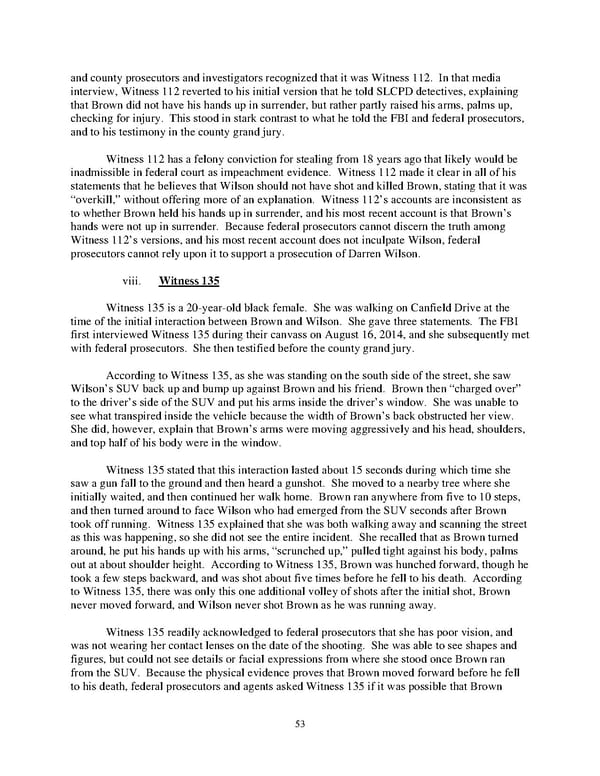and county prosecutors and investigators recognized that it was Witness 112. In that media interview, Witness 112 reverted to his initial version that he told SLCPD detectives, explaining that Brown did not have his hands up in surrender, but rather partly raised his arms, palms up, checking for injury. This stood in stark contrast to what he told the FBI and federal prosecutors, and to his testimony in the county grand jury. Witness 112 has a felony conviction for stealing from 18 years ago that likely would be inadmissible in federal court as impeachment evidence. Witness 112 made it clear in all of his statements that he believes that Wilson should not have shot and killed Brown, stating that it was “overkill,” without offering more of an explanation. Witness 112’s accounts are inconsistent as to whether Brown held his hands up in surrender, and his most recent account is that Brown’s hands were not up in surrender. Because federal prosecutors cannot discern the truth among Witness 112’s versions, and his most recent account does not inculpate Wilson, federal prosecutors cannot rely upon it to support a prosecution of Darren Wilson. viii. Witness 135 Witness 135 is a 20yearold black female. She was walking on Canfield Drive at the time of the initial interaction between Brown and Wilson. She gave three statements. The FBI first interviewed Witness 135 during their canvass on August 16, 2014, and she subsequently met with federal prosecutors. She then testified before the county grand jury. According to Witness 135, as she was standing on the south side of the street, she saw Wilson’s SUV back up and bump up against Brown and his friend. Brown then “charged over” to the driver’s side of the SUV and put his arms inside the driver’s window. She was unable to see what transpired inside the vehicle because the width of Brown’s back obstructed her view. She did, however, explain that Brown’s arms were moving aggressively and his head, shoulders, and top half of his body were in the window. Witness 135 stated that this interaction lasted about 15 seconds during which time she saw a gun fall to the ground and then heard a gunshot. She moved to a nearby tree where she initially waited, and then continued her walk home. Brown ran anywhere from five to 10 steps, and then turned around to face Wilson who had emerged from the SUV seconds after Brown took off running. Witness 135 explained that she was both walking away and scanning the street as this was happening, so she did not see the entire incident. She recalled that as Brown turned around, he put his hands up with his arms, “scrunched up,” pulled tight against his body, palms out at about shoulder height. According to Witness 135, Brown was hunched forward, though he took a few steps backward, and was shot about five times before he fell to his death. According to Witness 135, there was only this one additional volley of shots after the initial shot, Brown never moved forward, and Wilson never shot Brown as he was running away. Witness 135 readily acknowledged to federal prosecutors that she has poor vision, and was not wearing her contact lenses on the date of the shooting. She was able to see shapes and figures, but could not see details or facial expressions from where she stood once Brown ran from the SUV. Because the physical evidence proves that Brown moved forward before he fell to his death, federal prosecutors and agents asked Witness 135 if it was possible that Brown 53
 DOJ Report on Shooting of Michael Brown Page 52 Page 54
DOJ Report on Shooting of Michael Brown Page 52 Page 54